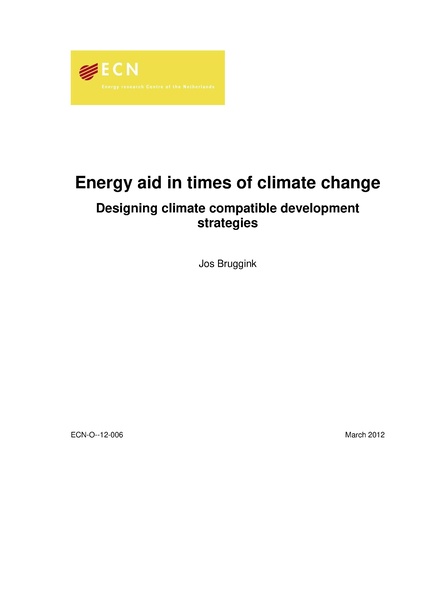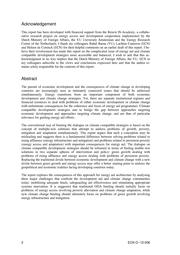File:Bruggink - Energy aid in times of climate change.pdf
 Size of this JPG preview of this PDF file: 424 × 600 pixels. Other resolution: 170 × 240 pixels. |
Original file (2,480 × 3,508 pixels, file size: 0 bytes, MIME type: application/pdf, 39 pages)
Summary
| Description |
English: The pursuit of economic development and the consequences of climate change in developing countries are increasingly seen as intimately connected issues that should be addressed simultaneously. Energy transitions form an important component of both economic development and climate change strategies. Yet, there are separate institutional regimes and financial resources to deal with problems of either economic development or climate change with unfortunate consequences for the coherence and focus of energy aid programmes. Climate compatible development strategies aim to bridge the gap between approaches targeting economic development and approaches targeting climate change, and are thus of particular relevance for guiding energy aid efforts.
The conventional way of framing the dialogue on climate compatible strategies is based on the concept of multiple-win solutions that attempt to address problems of growth, poverty, mitigation and adaptation simultaneously. This report argues that such a conception may be misleading and suggests there is a fundamental difference between solving problems related to rising affluence (energy infrastructure and mitigation) and problems related to persistent poverty (energy access and adaptation) with important consequences for energy aid. The dialogue on climate compatible development strategies should be reframed in terms of finding double-win solutions in two separate spheres of intervention and policy: green growth dealing with problems of rising affluence and energy access dealing with problems of persistent poverty. Replacing the traditional divide between economic development and climate change with a new divide between green growth and energy access may offer a better starting point to address the geopolitical and economic realities facing developing countries today. The report explores the consequences of this approach for energy aid architecture by analysing three major challenges that confront the development aid and climate change communities today: mobilizing adequate funds, safeguarding aid effectiveness and stimulating appropriate systems innovation. It is suggested that traditional ODA funding should initially focus on problems of energy access involving poverty alleviation and climate change adaptation, while new climate change funding should ultimately focus on problems of green growth involving energy infrastructure and mitigation. |
|---|---|
| Source |
VU University Amsterdam |
| Date |
2012-03-01 |
| Author |
Jos Bruggink |
| Permission |
See license tag below. |
Licensing
| This file is licensed under the Creative CommonsAttribution-NonCommercial 3.0 International license. | ||
|
File history
Click on a date/time to view the file as it appeared at that time.
| Date/Time | Thumbnail | Dimensions | User | Comment | |
|---|---|---|---|---|---|
| current | 14:09, 7 March 2016 |  | 2,480 × 3,508, 39 pages (0 bytes) | ***** (***** | *****) | User created page with UploadWizard |
You cannot overwrite this file.
File usage
There are no pages that use this file.





















